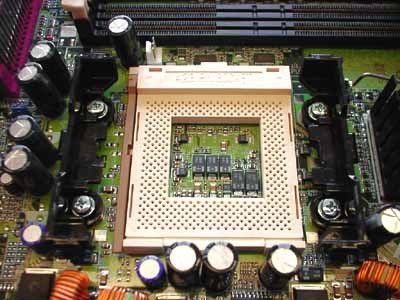A New Lease On Life - How To Make Your PC 5 Times Faster
Upgrading The CPU - Slot Or Socket Up To 1000 MHz
The Abit BX6's CPU platform is still based on the Slot 1 - a standard that Intel has been in the process of phasing out for some time now. Currently, processors (Pentium III) for Slot 1 up to 1000 MHz are still available in stores. Since the multiplier on all Pentium III processors is hard-wired, hardly any problems crop up in reality. Coming back to our Abit BX6, any Pentium III CPU could have been used on it. In the first upgrade phase, we used a Pentium III/800 with a front side bus of 133 MHz. This CPU is relatively inexpensive and performs fairly well - provided that it's not supposed to meet high-end standards of quality. All the Celeron processors are unattractive for an upgrade, since their second level cache of 128 kB is too small. As we said beforehand, we only want to exchange the processor in the first phase of stepping up our PC system. The remaining components will be installed step by step. There is one peculiarity of Pentium III processor, though - the 800 MHz comes with either 100 MHz front side bus or with 133 MHz FSB. The second version performs better than its 100 MHz counterpart. Another option involves installing a processor in the FCGPA case. To do this, however, you have to install a Socket adapter as well.
Intel processors at a glance - the lower CPU is our Pentium II/233, followed by a Pentium III/600 (Katmai core), a Pentium III/800 in a FCPGA case and a Pentium 4/1500.
Slot 1 - this CPU platform was replaced by the Socket 370. However, processors are still available up to 1000 MHz.
Socket 370 - the current standard for all Intel Celeron II processors (FCPGA version) and Pentium III processors.
Socket 423 - this platform has been conceived exclusively for use with the Pentium 4. The CPUs are clocked from 1300 MHz to 2000 MHz.
Get Tom's Hardware's best news and in-depth reviews, straight to your inbox.
Current page: Upgrading The CPU - Slot Or Socket Up To 1000 MHz
Prev Page Base PC Configuration Next Page Slot Adapter: New CPU In An Old Board


